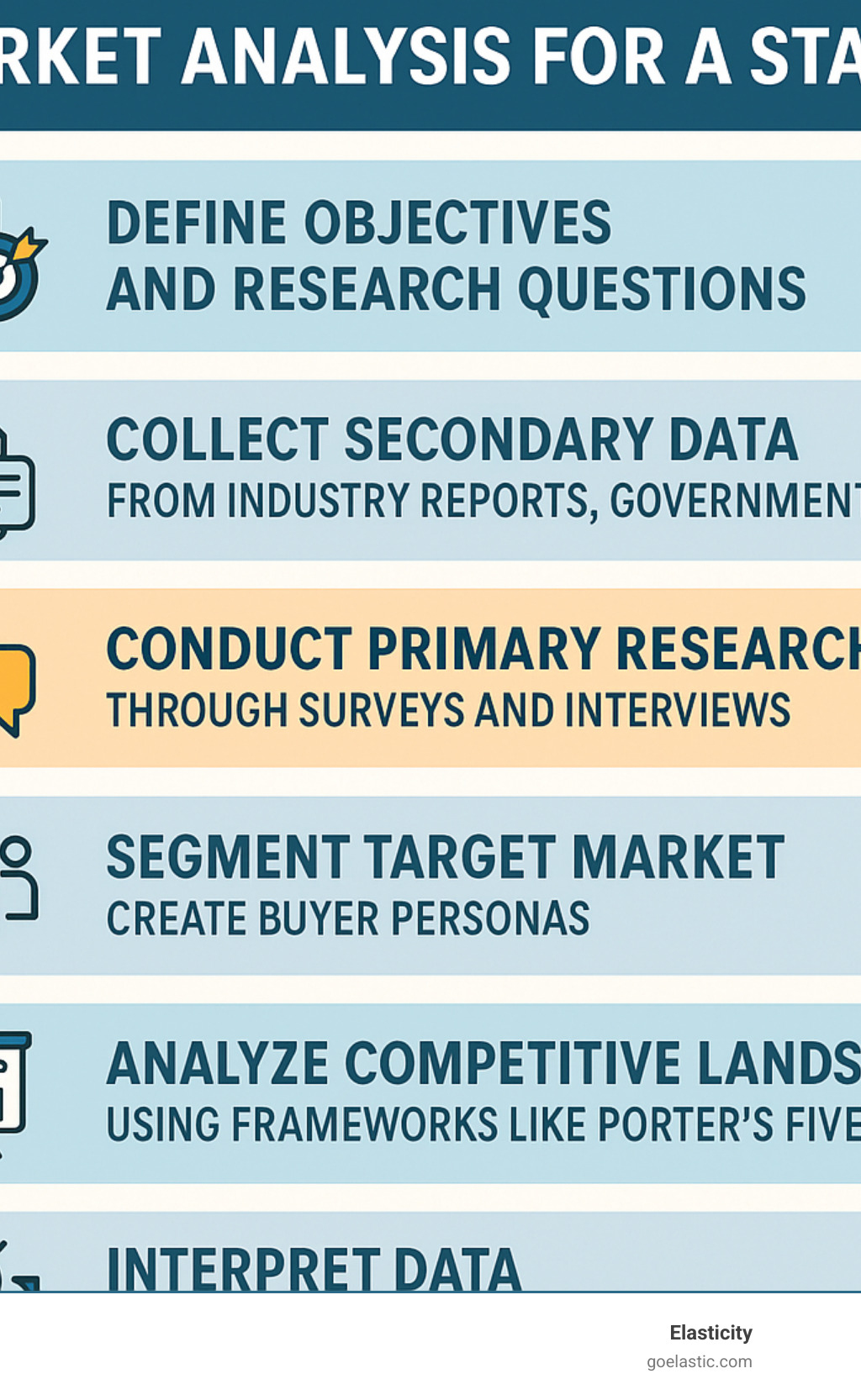How To Do Market Analysis For A Startup: 6 Powerful Steps 2025
Why Market Analysis is Critical for Startup Success
How to do market analysis for a startup involves six key steps: defining objectives, collecting secondary data, conducting primary research, segmenting your target market, analyzing competitors, and interpreting findings to validate your business idea.
Quick Answer: Market Analysis for Startups
1. Define your research goals – What questions need answers?
2. Gather industry data – Use free sources like SBA, Census Bureau
3. Talk to potential customers – Surveys, interviews, focus groups
4. Map your target audience – Create detailed buyer personas
5. Study competitors – Direct and indirect competition analysis
6. Validate and iterate – Use findings to refine your business model
The stakes couldn’t be higher. 50% of new businesses fail within the first five years, and according to CB Insights research, 42% of startup failures happen because there’s no market need for the product or service.
As one expert puts it: “Without market research, a startup is just making guesses.” – Dr. Elaine Young
Yet many founders skip this crucial step, relying on gut feelings instead of data. Smart entrepreneurs know better. They understand that market analysis isn’t just academic research—it’s the foundation that helps you find real customers, set the right prices, and avoid costly mistakes.
I’m Jen Stamulis, and I’ve spent over a decade helping companies like Nestlé Purina and Banc of California understand their markets and drive growth through data-driven strategies. Throughout my career, I’ve seen how to do market analysis for a startup effectively—and the dramatic difference it makes in long-term success.

Know your how to do market analysis for a startup terms:
– go-to-market strategy for startups
– business marketing strategies
– marketing and advertising costs for a startup business
Why Market Analysis Matters for Startups
Market analysis is the 30,000-foot view of your playing field. It tells you how big the opportunity is, who else is fighting for it, and whether customers truly care. That makes it different from market research (deep dives into customer preferences) or marketing analytics (campaign performance).
Skip this step and you risk joining the 42 % of startups that fail for lack of market need or the 20 % that get outmaneuvered by competition. As Dr. Elaine Young says: “Market analysis is the difference between building a product people want and building a product you hope people want.”
Key pay-offs:
– Investor credibility – walk into meetings with data, not guesses.
– Smarter pricing – know what buyers pay today and what premium they’ll tolerate.
– Growth roadmap – uncover new segments, geographies and add-on products.
– Risk control – spot threats (regulations, substitutes, new entrants) early.
– Partnership signals – identify distributors or tech partners before rivals do.
In short, market analysis gives you the confidence—and evidence—to commit scarce startup resources where they’ll matter most. For a full marketing build-out, see our guide on Marketing for Startup Business.
Step-by-Step: How to Do Market Analysis for a Startup
Our streamlined six-step process keeps you focused and fast:
- Define objectives & hypotheses – the specific questions that must be answered.
- Collect secondary data – government stats, trade reports, analyst briefs.
- Conduct primary research – surveys, interviews, focus groups.
- Segment & profile – build buyer personas and your Ideal Customer Profile.
- Analyze competitors – map direct/indirect rivals with tools such as Porter’s Five Forces.
- Interpret & validate – turn findings into forecasts, pricing, and a go/no-go call.
Along the way calculate TAM, SAM, and SOM to size the prize, and run a quick SWOT to know where you stand.
Markets evolve, so revisit the exercise quarterly in year one and annually after product-market fit. For additional techniques, explore How to Conduct Market Research.
1. Define Objectives & Hypotheses
Think of this step as setting your GPS before a road trip. You wouldn’t just hop in your car and start driving—you need to know exactly where you’re going. The same principle applies when learning how to do market analysis for a startup.
Your first task is crafting a clear problem statement that captures what you believe about your market opportunity. Let’s say you’re considering a meal planning service. Your problem statement might look like this: “We believe busy professionals aged 25-40 in Denver, Los Angeles, St. Louis, and Washington D.C. will pay $50/month for a meal planning service that saves them 5+ hours per week.”
Notice how specific this is? It’s not just “people want meal planning.” You’ve identified who, where, how much, and what benefit they’ll receive.
Now transform that problem statement into measurable goals that you can actually research. Ask yourself: Is there real demand among working professionals in these cities? What are people currently paying for similar time-saving solutions? How crowded is this market with competitors?
The magic happens when you turn these broad goals into specific research questions. Instead of asking “Do people want our product?”—which is way too vague—dig deeper: “How many hours per week do working professionals spend on meal planning, and how much would they pay to reduce this time by 75%?”
This focused approach keeps you from getting lost in endless data collection that doesn’t actually help your business decisions. Every survey question, every interview, every piece of research should connect back to these core objectives.
You’re not trying to learn everything about your market—you’re trying to answer the specific questions that will help you build a successful business.
2. Collect Secondary Data
Think of secondary research as your treasure hunt through existing data—and the U.S. government has already done most of the heavy lifting for you. The best part? It’s completely free and incredibly detailed.
Your first stop should be the NAICS (North American Industry Classification System). This might sound bureaucratic, but it’s actually your key to open uping relevant industry data. By defining your industry precisely through NAICS codes, you’ll find statistics and benchmarks that actually apply to your business instead of swimming in irrelevant numbers.
Once you have your industry classification, the Census Business Builder becomes your best friend. This tool provides detailed demographic and economic data broken down by geographic area. Planning to launch in Denver or Washington D.C.? You can get incredibly specific information about income levels, age distributions, and spending patterns in those exact markets.
The Bureau of Labor Statistics (BLS) offers another goldmine of information. Here you’ll find employment data, wage information, and consumer spending patterns organized by industry and region. This data helps you understand not just who your customers might be, but whether they have the disposable income to buy your product.
Don’t overlook the Small Business Administration’s research resources. The Scientific research on SBA data provides industry-specific insights that include typical startup costs and success rates. This information helps you benchmark your expectations against reality.
Professional associations and trade publications round out your secondary research. Many offer free executive summaries or basic statistics even when full reports require paid membership. The key is understanding how to do market analysis for a startup by casting a wide net initially, then focusing on the most relevant and recent data.
You’re looking for trends over time rather than isolated data points. Markets change constantly, and you need to understand the direction they’re heading, not just where they are today.
3. Conduct Primary Research
Secondary data gives the big picture; primary research supplies the on-the-ground truth.
• Surveys – Use Google Forms, SurveyMonkey, or Typeform to reach dozens or hundreds of prospects. Keep them to 5-10 neutral, behaviour-focused questions (e.g., “What did you spend on meal kits last month?”).
• Interviews – 15–20 half-hour calls let you probe deeper. Record (with permission), ask plenty of “Why?” follow-ups, and listen for emotional triggers that drive purchase decisions.
• Focus groups – 6-10 participants riffing together can surface objections or enthusiasm your one-on-one chats missed—perfect for early concept tests.
• Online communities – Lurk in relevant Reddit threads, Facebook Groups, or Slack channels to capture unfiltered pain points.
Always thank participants—a $20 gift card or early-access invite boosts response rates and data quality.
4. Segment & Profile Target Market
Here’s where how to do market analysis for a startup gets personal—and profitable. You can’t sell to everyone, so smart founders identify their most valuable customer segments and get to know them like close friends.
Think beyond basic demographics like age and income. While it’s helpful to know your customer is a 32-year-old marketing manager earning $85,000, that’s just scratching the surface. What really drives purchasing decisions are psychographics—their values, lifestyle choices, and daily frustrations.
Let’s say you’re developing that meal planning service we mentioned earlier. Two customers might have identical demographics but completely different motivations. One values convenience above all else and will pay premium prices for time-saving solutions. Another is budget-conscious and needs to see clear cost savings before switching from their current approach.

Creating detailed buyer personas brings your research to life. Instead of targeting “busy professionals,” you’re speaking to “Busy Professional Sarah”—a real person with specific challenges, preferences, and buying behaviors.
Sarah works 50+ hours per week at a Denver marketing firm. She currently spends $200 monthly on takeout and meal kits because she wants healthy food but lacks time for meal planning. Her primary frustration isn’t cooking itself—it’s the mental load of deciding what to eat and ensuring she has ingredients on hand.
Build 2-3 detailed personas based on your primary research interviews. Include their current solutions, price sensitivity, and decision-making process. Do they research extensively before buying, or make quick impulse purchases? Do they need approval from a spouse or business partner?
Your Ideal Customer Profile (ICP) combines the most attractive characteristics across segments. These are customers who not only buy quickly but also become advocates, have higher lifetime value, and cost less to acquire. Focus your limited startup resources on finding more people like your ICP rather than trying to appeal to everyone.
Pricing sensitivity varies dramatically between segments. Some customers will pay premium prices for convenience, while others need clear ROI justification. Understanding these differences helps you develop pricing strategies that maximize both sales volume and profit margins.
5. Analyze the Competitive Landscape
You compete with more than look-alikes. Direct competitors sell similar solutions; indirect competitors solve the problem differently (e.g., restaurants compete with your meal-planning app for “what’s for dinner” dollars).
Run Porter’s Five Forces for a quick pressure test:
1. New entrants: How easy is it to copy you?
2. Supplier power: Could key inputs drive your costs up?
3. Buyer power: Can customers easily switch or haggle?
4. Substitutes: Are there cheaper or simpler work-arounds?
5. Rivalry: Is the market fragmented or a cut-throat price war?
Next, pick the top 3-5 rivals and complete a one-page SWOT for each:
– Strengths: brand, funding, tech.
– Weaknesses: bad reviews, missing features.
– Opportunities: segments they ignore.
– Threats: regulation, tech shifts, economic trends.
Map pricing tiers, marketing channels and positioning. The goal isn’t to copy them—it’s to spot white space you can own.

Set Google Alerts and revisit this scan quarterly; markets move fast.
6. Interpret Data & Validate Idea
Now comes the moment of truth—turning all that research into actionable insights. How to do market analysis for a startup isn’t complete until you can recognize patterns that either support or challenge your business idea.
Start with pattern recognition across all your data sources. If your secondary research shows a growing market, your interviews reveal genuine customer pain points, and competitors have pricing gaps, you’re seeing positive alignment. But pay special attention to contradictions—they often reveal the most valuable insights.
Maybe industry reports suggest explosive growth, but every person you interviewed seems satisfied with their current solution. That disconnect tells you something important about market timing or customer awareness that could make or break your strategy.
Build your sales forecast using real numbers from your research. Take the number of potential customers in your target market, multiply by a realistic conversion rate (start conservative—1-3% is typical for new businesses), then multiply by your planned pricing. Don’t forget to subtract customer acquisition costs to get your actual revenue potential.
For example, if you identified 10,000 potential customers in Denver, expect a 2% conversion rate, and plan to charge $50/month, that’s 200 customers generating $10,000 monthly. But if customer acquisition costs $75 per customer, you need to factor in that $15,000 upfront investment.
Consider three scenarios: optimistic (everything goes better than expected), realistic (your best estimate), and pessimistic (challenges arise). This helps you plan for different outcomes and identify the key factors that will determine success.
Most importantly, use your findings to make pivot decisions if needed. Maybe your research revealed a different customer segment that’s more attractive, or a pricing model that works better than your original plan. That’s not failure—that’s exactly why you do this analysis before investing everything.
Remember to update your analysis regularly. Markets shift, new competitors emerge, and customer needs evolve. Plan to revisit your research quarterly, especially if you’re in a fast-moving industry where trends change rapidly.
Your market analysis is never truly “done”—it’s a living document that guides your startup’s evolution and growth.
Budget-Friendly Data Sources & Tools
Great insights don’t require a giant budget:
Free federal data:
– Census Bureau – demographics and consumer spending.
– BLS – employment, wage, and time-use statistics.
– SBA – startup cost benchmarks by industry.
Low-cost DIY stack:
– Google Forms / SurveyMonkey / Typeform – surveys.
– Google Analytics – trend spotting.
– Google Alerts + Mention – competitor and keyword monitoring.
– Local library databases – free access to pricey IBISWorld or Statista reports.
Polls on LinkedIn, Twitter, and Instagram Stories can deliver hundreds of quick data points overnight. For more on stretching marketing dollars, see Digital Marketing for Startups.
Common Pitfalls & Best Practices
Avoid these classic traps:
- Confirmation bias: Hunting only for data that proves your idea. Assign a teammate to play devil’s advocate.
- Tiny sample sizes: Friends and family ≠ market validation. Aim for ≥100 survey responses for quantitative calls.
- Leading questions: Keep wording neutral and randomise answer orders.
- Out-of-date data: Pre-COVID reports can mislead in 2025 and beyond.
- Geographic blind spots: Test multiple regions if you plan to scale.
Best practices:
– Triangulate findings across sources.
– Document assumptions and test them iteratively.
– Re-run a slimmed-down analysis every quarter in year one, then annually.

Frequently Asked Questions about Startup Market Analysis
What’s the quickest way to estimate market size?
Use a top-down figure from an industry report, then sanity-check with a bottom-up count of target customers × expected spend. If the two numbers are wildly different, dig deeper.
How often should we update the analysis?
Quarterly in year one, annually after product-market fit—plus immediately if a major competitor, regulation, or economic shock appears.
Primary vs. secondary research?
Secondary = existing data (government stats, analyst reports). Primary = fresh data you collect (surveys, interviews). Combine both for a full picture.
Conclusion & Next Steps
You now have everything you need to master how to do market analysis for a startup. This isn’t just busy work or something to check off your to-do list—it’s literally the difference between joining the 42% of startups that fail due to lack of market need and building a business that customers actually want.
Think about it this way: every hour you spend on market analysis could save you months of building the wrong product or targeting the wrong customers. The six-step framework we’ve covered gives you a clear path forward, whether you’re validating your first business idea or exploring new markets for an existing startup.
Start small but start now. Begin with secondary research to get your bearings, then dive into conversations with real potential customers. Don’t worry about having perfect data—focus on gathering enough insights to make informed decisions and avoid the biggest pitfalls.
Market analysis is more like tending a garden than building a house. You can’t do it once and walk away. Markets shift, new competitors emerge, and customer needs evolve. Plan to revisit your analysis quarterly, especially in your first year when everything changes rapidly.
The most successful founders I’ve worked with treat market research as an ongoing conversation with their customers, not a one-time project. They’re constantly curious about what drives their market and humble enough to let data challenge their assumptions.
Ready to turn all these insights into a marketing strategy that actually works? At Elasticity, we help startups bridge the gap between market research and real growth. Our marketing, advertising & brand design services are designed specifically for companies that want to build their marketing on solid data rather than guesswork.
Your market analysis is just the beginning. Now it’s time to use what you’ve learned to build something people truly need.


